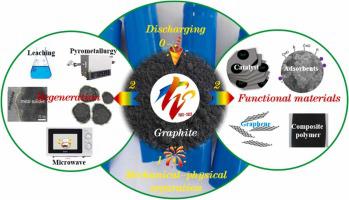Journal of Hazardous Materials ( IF 12.2 ) Pub Date : 2022-07-26 , DOI: 10.1016/j.jhazmat.2022.129678 Bo Niu 1 , Jiefeng Xiao 2 , Zhenming Xu 2

|
Spent lithium-ion batteries (LIBs) have been one of the fast-growing and largest quantities of solid waste in the world. Spent graphite anode, accounting for 12-21 wt% of batteries, contains metals, binders, toxic, and flammable electrolytes. The efficient recovery of spent graphite is urgently needed for environmental protection and resource sustainability. Recently, more and more studies have been focused on spent graphite recycling, while the advance and challenges are rarely summarized. Hence, this study made a comprehensive review of graphite recycling including separation, regeneration, and synthesis of functional materials. Firstly, the pretreatment of graphite separation was overviewed. Then, the spent graphite regeneration methods such as leaching, pyrometallurgy, their integration processes, etc. were systematically introduced. Furthermore, the modification strategies to enhance the electrochemical performance were discussed. Subsequently, we reviewed in detail the synthesis of functional materials using spent graphite for energy and environmental applications including graphene, adsorbents, catalysts, capacitors, and graphite/polymer composites. Meanwhile, we briefly compared the economic and environmental benefits of graphite regeneration and other functional materials production. Finally, the technical bottlenecks and challenges for spent graphite recycling were summarized and some future research directions were proposed. This review contributes to spent LIBs recycling more efficiently and profitably in the future.
中文翻译:

废旧锂离子电池负极石墨回收的进展与挑战
废锂离子电池 (LIB) 已成为世界上快速增长且数量最多的固体废物之一。废石墨阳极,占比12-21 wt% 的电池,含有金属、粘合剂、有毒和易燃电解质。环保和资源可持续性迫切需要高效回收废石墨。最近,越来越多的研究集中在废石墨回收上,但很少总结其进展和挑战。因此,本研究对功能材料的分离、再生和合成等石墨回收进行了全面综述。首先对石墨分离的预处理进行了概述。接着,系统介绍了浸出法、火法冶金法等废石墨再生方法及其集成工艺。此外,还讨论了提高电化学性能的修饰策略。随后,我们详细回顾了使用废石墨合成用于能源和环境应用的功能材料,包括石墨烯、吸附剂、催化剂、电容器和石墨/聚合物复合材料。同时,我们简要比较了石墨再生和其他功能材料生产的经济效益和环境效益。最后总结了废石墨回收的技术瓶颈和挑战,并提出了一些未来的研究方向。该审查有助于在未来更有效和更有利地回收用过的 LIB。我们简要比较了石墨再生和其他功能材料生产的经济和环境效益。最后总结了废石墨回收的技术瓶颈和挑战,并提出了一些未来的研究方向。该审查有助于在未来更有效和更有利地回收用过的 LIB。我们简要比较了石墨再生和其他功能材料生产的经济和环境效益。最后总结了废石墨回收的技术瓶颈和挑战,并提出了一些未来的研究方向。该审查有助于在未来更有效和更有利地回收用过的 LIB。











































 京公网安备 11010802027423号
京公网安备 11010802027423号